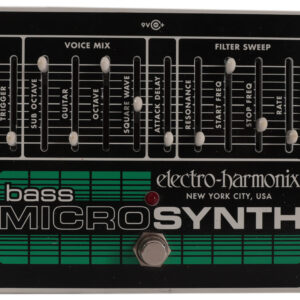Description
The Electro Harmonix Bass Mono Synth Pedal is currently retailing at £129.99 and it is in stock. Available to be delivered to you by post direct (some charge may apply).The team at Just Pedals think that Electro Harmonix nailed it with the Electro Harmonix Bass Mono Synth Pedal.
Turn your bass into a synth with the Electro Harmonix Mono Synth – a pedal packed with crazy sounds, from vintage semi modular tones to fat voicings and soaring leads.
The American company have been making legendary pedals since their inception in 1960 and the Mono Synth is yet another awesome stompbox added to the line-up. Boasting the likes of the Memory Man delay, Synth9, Pog and Superego, they're not short on synth emulators. These guys know what a great synth sounds like.
Presets
Add colour and flavour to your bass sound with the 11 presets packed into the Mono Synth. Despite just the two tone dials in the form of Control and Sensitivity, there's a whole lot lot explore. Sounds range from a classic '80s vibe Cosmic and Growl to the 8-bit Unison and Laser settings. Get classic square waves from Twin or modern swells from Wub.
All settings work great with other Electro Harmonix pedals in the range, especially the Canyon and Holy Grail reverb or Big Muff for a bit of crunch. The Mono Synth is monophonic, so play one note at a time for awesome old-school leads.
Versatility
It's really easy to set the 11 separate presets for each sound type. Simply hold down the preset footswitch and it's locked in. You can jump from one tone to another with a simple step on the Mono Synth. Hook the stompbox up to an expression pedal for real-time effect. Place at the start of your pedal chain for best results rather than in the effects loop.
Specifications
- 11 Synth sounds
- Works without MIDI
- Controls: Sensitivity, Volume, Control
- Expression Pedal Input
- 11 Preset Save Slots
- Synth & Dry outputs
- 9V PSU
































![[Power Specifications] Input voltage: AC 100-240V 50/60Hz, extension cord 5 feet. [Wide use] Widely used in hand-washing counters, Halloween decorations, handheld vacuum cleaners, security equipment, liquid crystal displays, LED lights, light-emittin...](https://m.media-amazon.com/images/I/41LRcg88jPS._SL160_.jpg)



